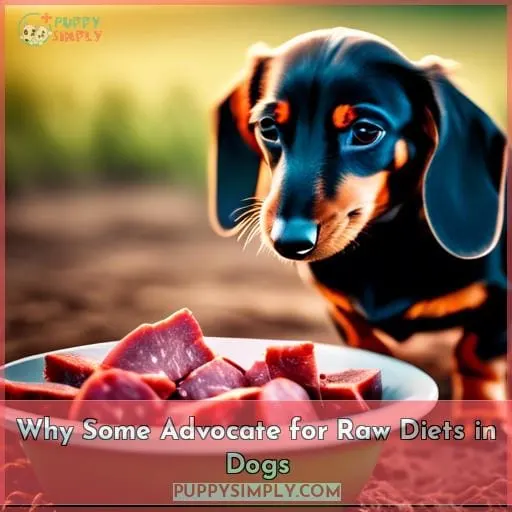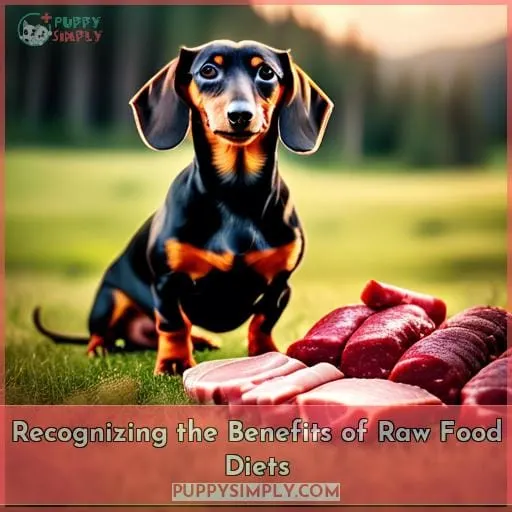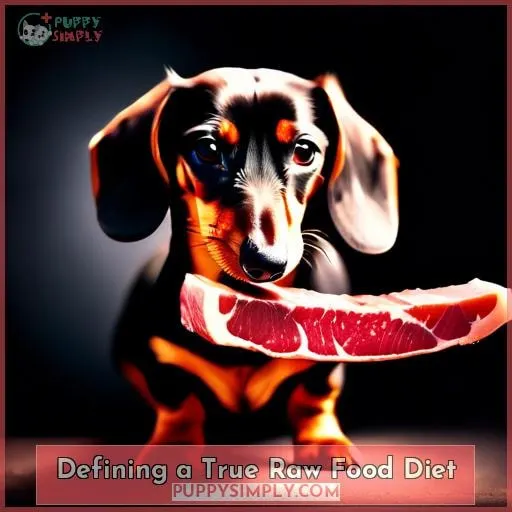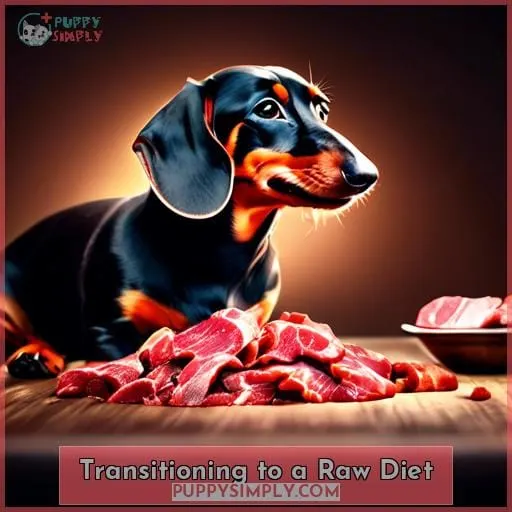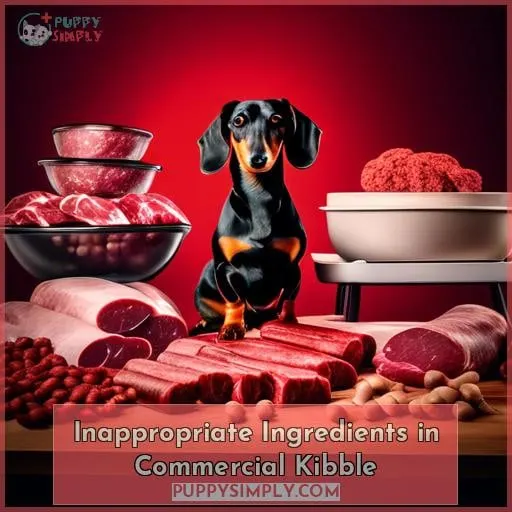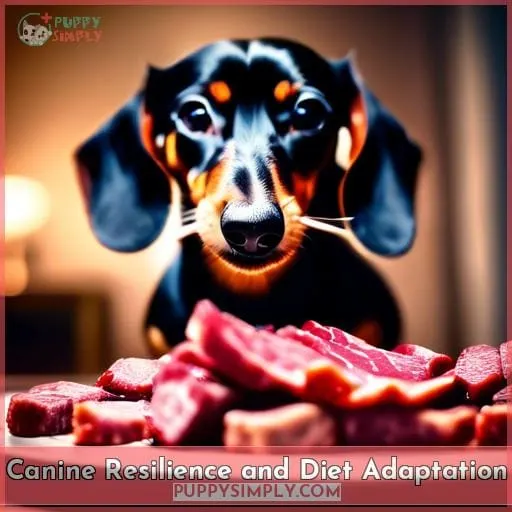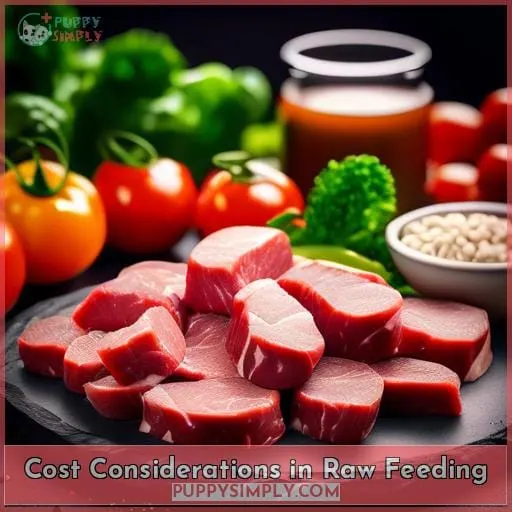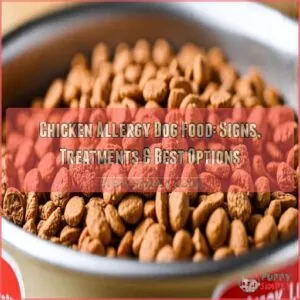This site is supported by our readers. We may earn a commission, at no cost to you, if you purchase through links.
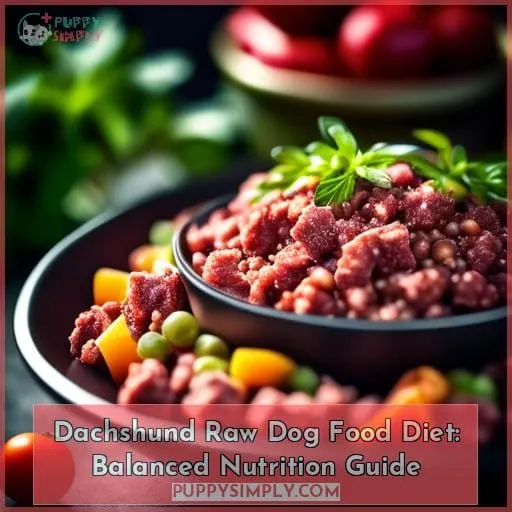 Embarking on a raw dog food diet for your Dachshund can be like unlocking their ancestral vigor. Just as a key fits perfectly into a lock, a balanced raw diet aligns with your pet’s carnivorous needs, potentially rejuvenating their health and spirit.
Embarking on a raw dog food diet for your Dachshund can be like unlocking their ancestral vigor. Just as a key fits perfectly into a lock, a balanced raw diet aligns with your pet’s carnivorous needs, potentially rejuvenating their health and spirit.
If you’re considering this path, you’ll want to weigh the benefits, such as enhanced vitality and allergy management, against the risks, including bacterial exposure and nutritional balance. This guide will navigate the intricacies of a Dachshund raw dog food diet, ensuring your furry friend thrives on a diet that’s as close to nature as possible.
Table Of Contents
- Key Takeaways
- Why Some Advocate for Raw Diets in Dogs
- The Debate Over Raw Diets for Dogs
- Recognizing the Benefits of Raw Food Diets
- Defining a True Raw Food Diet
- Transitioning to a Raw Diet
- The Anatomy and Digestion of Canines
- Inappropriate Ingredients in Commercial Kibble
- Canine Resilience and Diet Adaptation
- Cost Considerations in Raw Feeding
- Frequently Asked Questions (FAQs)
- Conclusion
Key Takeaways
- Raw diets for Dachshunds can lead to enhanced vitality, improved coat health, and better digestion, but require careful planning to ensure nutritional balance.
- Incorporating a variety of meats, bones, offal, and some plant-based ingredients is crucial for providing a balanced diet that mimics what Dachshunds would naturally eat.
- While raw diets can offer health benefits, they also come with risks such as bacterial contamination and potential nutritional imbalances, highlighting the importance of choosing reputable sources and possibly consulting with a veterinarian.
- The cost of feeding a Dachshund a raw diet can vary significantly, with commercially prepared raw foods being more expensive, but potentially offering long-term health benefits that may offset the higher upfront costs.
Why Some Advocate for Raw Diets in Dogs
You’re considering a raw diet for your Dachshund because you want what’s best for their health and well-being.
The ancestral diet philosophy suggests that a diet mimicking what dogs ate in the wild—primarily raw meat, bones, and organs—can lead to a happier, healthier pet.
Additionally, a raw diet allows for customization to meet your Dachshund’s specific nutritional needs, potentially preventing common health issues and allergies.
Ancestral Diet Philosophy
As a dog owner, you may have heard about the ancestral diet philosophy for canines. Proponents believe that dogs, like their wolf ancestors, should eat a raw diet consisting of meat, bones, and organs.
They argue that this diet is more natural and nutritious than processed kibble, which they believe can lead to health problems.
- Paleo Diet for Pets
- Natural Nutrition for Dogs
- Evolutionary Biology and Wolf Ancestry
Customization for Nutritional Needs
Continuing from the ancestral diet philosophy, let’s chew over the idea of customization for nutritional needs.
You see, every pooch is unique, and a one-size-fits-all kibble bag doesn’t always cut it. That’s where raw food diets come into play, offering a smorgasbord of options for allergy management, weight control, and longevity promotion.
With tools like a raw food calculator, you can tailor your Dachshund’s diet with surgical precision. Whether you opt for homemade raw food or commercially prepared raw food, you’re taking a holistic approach to your furry friend’s nutrition.
Perfectly Rawsome and raw feeding from A to Z guides can help you craft a menu that’s the dog’s dinner for your Dachshund’s specific needs.
The Debate Over Raw Diets for Dogs
As you consider transitioning your Dachshund to a raw dog food diet, it’s crucial to weigh both sides of the ongoing debate.
On one hand, proponents argue that raw diets mimic ancestral eating patterns and can lead to improved health outcomes, such as shinier coats and better dental health. However, critics raise concerns about the potential risks associated with raw feeding, including bacterial contamination and nutritional imbalances.
Additionally, while some studies suggest slight health improvements in dogs on raw diets, the scientific community calls for more robust evidence to conclusively support these claims. It’s essential to approach this dietary change with a comprehensive understanding of both the potential benefits and risks, ensuring your Dachshund’s health and well-being remain the top priority.
Evolutionary Changes in Canines
As you chew over the idea of a dachshund raw dog food diet, it’s crucial to digest the fact that our furry friends have undergone genetic adaptations due to domestication.
While they may share a family tree with wolves, breed differences and age considerations mean that one size doesn’t fit all when it comes to diet.
Veterinary opinions are key ingredients in this balanced nutrition guide, ensuring that the health benefits you’re hoping for aren’t just a flash in the pan.
Nutritional Balance in Commercial Foods
While you’ve been pondering the ancestral diet of your dachshund, don’t overlook the modern convenience and nutritional balance of commercial kibble. These foods are formulated to meet all of your pup’s dietary needs and are regulated to ensure safety.
However, it’s not all biscuits and gravy; some kibble contains additives that raise eyebrows. Kibble processing methods have evolved to include extrusion and baking, but this can sometimes denature nutrients.
Vet bias in food recommendations is a hot topic, with some suggesting that pet food marketing sways professional opinions. And let’s not forget the cost of feeding a dachshund a raw diet—it can chew through your wallet faster than your furry friend through a bone.
Bacterial Risks and Scientific Evidence
Continuing from the discussion on the nutritional balance of commercial foods, let’s delve into the bacterial risks and scientific evidence surrounding raw dog food diets.
If you’re considering a raw diet for your dachshund, it’s crucial to weigh the potential for bacterial contamination against the benefits. Scientific research has shown that raw pet foods are more likely to harbor pathogens like Salmonella and Listeria monocytogenes.
While the idea of a balanced nutrition plan that mirrors ancestral diets is appealing, the lack of scientific evidence supporting the long-term benefits of raw diets can’t be ignored. It’s not just about your dachshund’s health; handling raw food also poses a risk to you.
So, before you leap into the raw food trend, it’s wise to chew over the facts and consult with your vet. After all, you want your furry friend to be the picture of health, not a pup playing Russian roulette with bacteria.
Recognizing the Benefits of Raw Food Diets
Recognizing the benefits of raw food diets for dogs, particularly Dachshunds, involves understanding the positive impacts on health and vitality, as well as the potential for allergy and weight management.
Transitioning to a raw diet can lead to noticeable improvements in a dog’s coat, energy levels, and overall well-being. Proponents argue that raw diets provide a more natural, less processed form of nutrition that closely mirrors what dogs would eat in the wild, contributing to superior joint and bone health, strengthened immune systems, and improved digestion.
These diets typically consist of raw meat, bones, organs, and sometimes a small amount of vegetables or supplements, aiming to replicate a dog’s ancestral diet.
However, it’s important to approach raw feeding with caution and informed preparation. While many dog owners report positive changes in their pets, such as shinier coats, increased energy, and smaller, less odorous stools, these benefits are often based on anecdotal evidence.
Critics of raw diets point to the risks of bacterial contamination, the challenge of ensuring nutritional balance, and the lack of scientific evidence supporting long-term benefits. Additionally, raw diets can be more expensive and require more storage and preparation time than traditional kibble.
For those considering a raw diet for their Dachshund, starting with commercially prepared raw food can offer a convenient and safer way to ensure nutritional balance. It’s also recommended to transition gradually to avoid stomach upset and to consult with a veterinarian to tailor the diet to the dog’s specific health needs and conditions.
Ultimately, the decision to feed a raw diet should be based on thorough research, consideration of the dog’s individual health, and ongoing monitoring of their well-being.
Health and Vitality Improvements
Continuing from the debate over raw diets, let’s delve into the health and vitality improvements you might see with a raw food diet for your Dachshund.
- A coat so shiny it could double as a mirror,
- Energy levels that turn your lazy Sunday into a marathon session of fetch,
- And poops so small and odorless, you’ll wonder if they’ve mastered the art of clean disappearing acts.
These benefits aren’t just for show; they’re signs of a thriving dog, inside and out. Raw food safety is paramount, so always handle with care to prevent digestion issues. While kibble vs. raw debates continue, the potential long-term effects of a raw diet—like extended life and improved quality of life—can’t be ignored.
Remember, a shiny coat is more than just vanity; it’s a reflection of good health.
Allergy and Weight Management
Switching your dog to a raw food diet can be a game-changer for managing allergies and weight. If your pooch is itching like they’re trying to scratch a winning lottery ticket or carrying a few extra pounds, a raw diet might just be the ticket.
Think of it as a dietary makeover: swapping out the kibble for a mix of raw meat, bones, and organs, with a sprinkle of ground-up veggies, a crack of raw egg, and a splash of fish oil for good measure.
Homemade raw diets can be a labor of love, but they allow for tailoring meals to your furry friend’s specific needs. On the other hand, premade raw options are the fast track to convenience—just thaw and serve! Either way, you’re likely to notice some pleasant side effects: smaller poops that won’t clear the room and a waistline that’s easier to maintain than a succulent garden.
Defining a True Raw Food Diet
When considering a raw food diet for your Dachshund, it’s crucial to understand what constitutes a true raw diet.
You’ll want to ensure that the diet consists of unprocessed raw meat, bones, and organs, possibly supplemented with vegetables, to closely mimic what their ancestors consumed.
Commercially prepared raw foods offer convenience and are designed to meet safety standards, but it’s important to verify that they haven’t undergone excessive processing that would classify them as something other than a true raw diet.
Raw Vs. Processed Diets
Transitioning from the benefits of raw food diets to the debate of raw vs. processed diets, it’s crucial to peel back the layers and understand what truly constitutes a raw diet for your furry friend.
-
Raw vs. Cooked: While raw diets boast benefits like improved dental health and energy, cooked or processed options, including grain-free kibble, mightn’t offer the same nutritional integrity due to high-heat processing.
-
Homemade Recipes: Diving into making your own raw dog food can be a rewarding yet challenging adventure. It allows for customization but requires a keen eye on nutritional balance and safety.
-
Buying Pre-Made Raw Dog Food: For those less inclined to keep the tail wagging in the kitchen, commercially prepared raw foods offer convenience and are often tested for safety, easing transitioning difficulties.
Commercial Raw Food Safety
When opting for commercial raw food, safety takes center stage. Unlike homemade raw food, commercially prepared options undergo meticulous sterilization processes to eliminate the risk of bacterial contamination.
Pre-made food is tested rigorously to ensure it meets stringent safety regulations, giving you peace of mind.
By choosing commercial raw food, you can provide your furry friend with the benefits of a raw diet while minimizing the risks associated with handling raw meat.
Transitioning to a Raw Diet
When considering a switch to a raw diet for your Dachshund, it’s crucial to start with a commercially prepared option to ensure nutritional balance and ease of use.
Transitioning your dog’s diet should be done gradually to minimize digestive upset and allow their system to adjust to the new food regimen.
Starting With Commercial Raw Food
Starting with commercially prepared frozen raw food is a smart move for those dipping their toes into the raw diet waters for their furry friends. It’s like having a nutritionist do the hard work for you, ensuring your dog gets the balanced diet they need without the guesswork.
Plus, it’s convenient—just thaw and serve! But remember, portion sizes matter. Too little and your dog might give you the side-eye, too much and you’re in for some not-so-pleasant surprises.
Ethical sourcing is another plus, giving you peace of mind that your dog’s dinner didn’t come at the cost of another animal’s welfare. And let’s not forget about storage—your freezer is about to become your best friend.
Keeping a stash of frozen raw food means you’re always prepared, even on those hectic days.
Lastly, don’t go it alone; veterinary guidance is key. They’re like the GPS for your dog’s nutrition journey, helping you navigate through the twists and turns of dietary needs and health considerations.
So, grab your dog, a freezer full of raw goodies, and embark on this journey to a happier, healthier pup.
Gradual Diet Change
Transitioning your dog to a raw food diet is a journey that requires patience, observation, and a bit of culinary adventure.
- Start Slow: Begin with a mix that’s mostly their current food, gradually increasing the raw component. This gradual transition helps their digestive system adjust without causing upset.
- Monitor Closely: Keep an eye on their reaction. Every dog is unique, and some may need a slower transition than others, especially if they’ve a sensitive stomach.
- Safety First: Opt for commercially prepared raw foods initially. These are designed to meet nutritional needs and are tested for safety, reducing the risk of bacterial contamination.
The Anatomy and Digestion of Canines
When considering a raw diet for your Dachshund, it’s essential to understand their digestive system and nutritional needs.
Dogs, including Dachshunds, have digestive tracts that haven’t significantly evolved from their wild ancestors, making them well-suited for diets rich in animal-based proteins like meat, bones, and offal.
This species-appropriate nutrition mimics the natural diet of wild canines, providing a balanced diet tailored to their life stage and energy needs.
High-quality proteins, healthy fats, vitamins, minerals, and fiber from vegetables and berries are crucial components of a raw diet for Dachshunds, ensuring they receive all necessary nutrients for optimal health.
Similarities to Wild Canine Diets
When transitioning to a raw diet for your Dachshund, understanding the anatomy and digestion of canines is crucial. Your furry friend’s digestive system is remarkably similar to that of their wild ancestors, like wolves.
This means they’re naturally equipped to handle a diet rich in raw meat, bones, and organs—ingredients that provide species-appropriate nutrition.
Wild canine diets emphasize the importance of scavenger adaptations, which have allowed dogs to thrive on a variety of foods, but they show optimal health when consuming diets that include raw meat and bone consumption.
This not only aids in dental health by reducing plaque and tartar buildup but also ensures they’re getting the right balance of nutrients.
The Role of Meat, Bones, and Offal
Continuing from the discussion on the ancestral diet of canines, let’s chew over the role of meat, bones, and offal in your Dachshund’s diet.
These aren’t just tasty treats; they’re the bedrock of a raw diet. Bone marrow is a treasure trove of nutrients, supporting not only bone composition but also enriching the blood.
Organ nutrition is no joke either; think of offal as nature’s multivitamin, packing a punch for your pup’s overall health. And let’s not forget about calcium absorption—essential for those tiny Dachshund frames.
Offal supplementation? It’s like hitting the jackpot for your dog’s diet, ensuring they get all the good stuff without the bad.
Inappropriate Ingredients in Commercial Kibble
Commercial kibble often includes carbohydrates and other ingredients that can stress your dog’s digestive system and denature essential nutrients.
These factors can lead to inflammation and various health conditions, impacting your dog’s overall well-being.
Carbohydrates and Digestive Stress
When you’re sizing up the kibble aisle, you might not realize that those crunchy bites could be putting your pup’s digestive health on the back burner.
Many commercial dog foods are packed with starchy carbs that can lead to a doggy version of a sugar rush. High glycemic index? Check. Potential for bacterial overgrowth and inflammation risk? Double-check.
It’s like feeding your dog a loaf of white bread and expecting them to be in tip-top shape. But let’s be real, your dog’s stomach isn’t a breadbox. They’re descendants of wolves, and their digestive system is built for a species-appropriate diet—think more meat market, less bakery.
So, if you want to keep your furry friend’s tail wagging and their tummy happy, you might want to think twice before tossing another bag of carb-heavy kibble into your cart.
Nutrient Denaturation and Health Impacts
When you’re eyeing that bag of kibble, you mightn’t realize you’re also eyeing a cocktail of denatured nutrients. High heat in kibble production is like a wrecking ball to vitamins and proteins, leaving them as useful as a chocolate teapot.
It’s a bit like cooking the life out of your veggies—sure, they’re edible, but you’ve kissed goodbye to half the goodness. Raw meat, on the other hand, sidesteps this nutritional demolition derby. It’s all about keeping those nutrients intact and steering clear of the inflammatory response that can come from those overcooked, carb-heavy kibbles.
Plus, you’re dodging the bacterial contamination bullet that’s a risk with poorly handled raw diets. It’s a balancing act, really—aiming for that sweet spot of nutritional balance and digestive health without playing Russian roulette with bacteria.
Canine Resilience and Diet Adaptation
Dogs, like their wild cousins, are remarkable in their ability to adapt to a variety of diets, a trait that has allowed them to thrive alongside humans for thousands of years. This resilience is rooted in their scavenger origins, enabling them to digest a range of foods, not just the ancestral diet of raw meat, bones, and organs.
However, this doesn’t mean that all diets are equally beneficial for our canine friends.
The modern kibble formulation, while convenient, often includes high levels of carbohydrates, which can be challenging for dogs to process due to their inherent carbohydrate intolerance. This is a stark contrast to the diet of their wild ancestors, which was rich in protein and fat but low in carbohydrates.
The inclusion of such ingredients in commercial kibble can lead to various health issues, including obesity and diabetes, due to the unnatural stress it places on their digestive systems.
Understanding this, it’s clear why many dog owners are turning back to what they see as a more natural feeding approach. A raw food diet attempts to mimic the ancestral diet of dogs, focusing on raw meat, bones, and organs, with some added vegetables or supplements for a balanced nutrition.
This diet is believed to be more in line with their digestive adaptation, potentially leading to better health outcomes.
However, it’s essential to approach the raw diet with a critical eye. While dogs have shown incredible dietary resilience, thriving on a range of diets, the shift to a raw diet should be done thoughtfully, considering the individual dog’s health, lifestyle, and nutritional needs.
Consulting with a veterinarian can provide guidance tailored to your dog’s specific requirements, ensuring they receive the benefits of a raw diet without the risks.
Cost Considerations in Raw Feeding
When considering a raw diet for your Dachshund, it’s important to weigh the financial implications alongside the health benefits.
Commercially prepared raw foods offer convenience and nutritional balance but come at a higher cost, ranging from $120 to $200 per month for a miniature Dachshund.
On the other hand, preparing raw food at home can be more economical, potentially cutting costs in half compared to commercial options.
It’s crucial to factor in these costs and benefits to determine the best feeding approach for your pet’s health and your budget.
Comparing Homemade and Commercial Costs
After exploring your dog’s resilience to various diets, let’s chew on the bone of cost between homemade and commercial raw diets.
Homemade meals offer a paw-some blend of affordability and customization, but require a bit of elbow grease in preparation and storage.
On the flip side, commercial options are a walk in the park for convenience, albeit with a heftier price tag.
Long-term Health Cost Benefits
Switching your Dachshund to a raw diet could mean fewer vet visits and a happier wallet in the long run. By focusing on a diet that’s closer to what nature intended, you’re investing in your furry friend’s health longevity.
Economic impact? It’s true, the upfront costs might pinch, but nutritional comparison shows that raw diets often lead to better overall health, potentially saving you a bundle on veterinary expenses. Plus, diet sustainability isn’t just a buzzword—it’s about keeping your pooch in tail-wagging shape for years to come.
Frequently Asked Questions (FAQs)
How to balance raw diets with seasonal allergies?
To balance raw diets with seasonal allergies, start with hypoallergenic meats like rabbit or goat, avoiding common allergens.
Gradually introduce new proteins, monitor reactions, and consult a vet for tailored advice.
Keep it varied and watchful!
Can raw diets affect a Dachshund’s behavior?
You can’t teach an old dog new tricks, but switching your Dachshund to a raw diet might just do the trick for their behavior.
It’s been noted that raw diets can lead to calmer, more obedient dogs with increased energy.
What are the risks of homemade raw diets?
You’re playing with fire when you whip up a raw feast for Fido at home.
Without a nutritionist’s know-how, you might miss essential nutrients.
There’s always the risk of uninvited bacteria like Salmonella crashing the dinner party.
How to ensure a raw diet is complete for puppies?
To ensure a raw diet is complete for puppies, you’ll want to think like a canine gourmet chef. Start with a single protein source and gradually introduce variety, including muscle meat, organs, and bones for calcium.
Don’t skimp on the veggies—they’re the unsung heroes for fiber and nutrients. And remember, supplements are your secret ingredient for a balanced meal.
Keep an eye on their growth and adjust portions as needed, and always consult with a vet who’s savvy in raw diets to ensure your pup’s menu is Michelin-star worthy.
Are there any breed-specific considerations for raw diets?
For raw diets, consider your dog’s size, activity level, and health.
Small breeds like Dachshunds need careful bone sizing to prevent choking and tailored portions to avoid obesity.
Always consult a vet for personalized advice.
Conclusion
Embarking on a raw diet for your Dachshund is a journey back to nature, juxtaposing the simplicity of ancestral diets with the complexity of modern nutritional science.
By choosing a Dachshund raw dog food diet, you’re not just feeding your pet; you’re embracing a philosophy that seeks to align with their natural dietary needs.
This guide has illuminated the path, highlighting both the glowing benefits and the potential pitfalls.
As you weigh the vibrant health and vitality against the risks of bacterial exposure and the challenge of achieving nutritional balance, remember that your commitment to understanding and carefully implementing this diet can lead to a thriving, happier Dachshund.
Let this be your guide to a balanced, species-appropriate diet that honors your furry friend’s ancestral lineage while navigating today’s world of pet nutrition.

